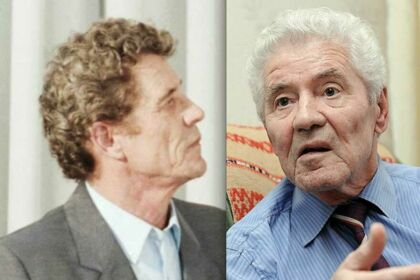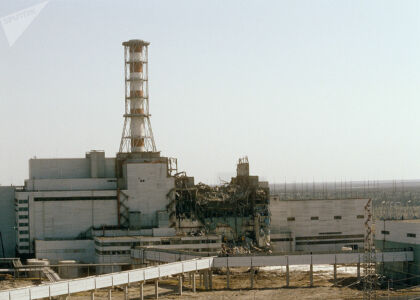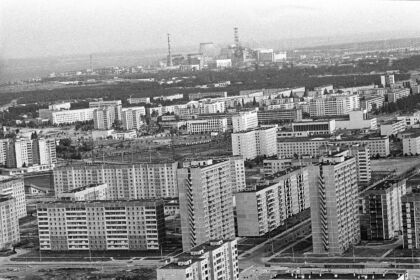The first director of the Chernobyl Nuclear Power Plant (ChNPP), Viktor Bryukhanov died on 13 October 2021 at the age of 85, according to the press service of the station on Facebook.
In recent years, Bryukhanov suffered two strokes, which, combined with radiation sickness, which manifested itself after the accident at the nuclear power plant, had a detrimental effect on his health.
He headed the Chernobyl NPP from its inception until the catastrophe of April 26, 1986, which became the largest nuclear power plant accident in human history.
Bryukhanov was 85 years old, when the press service of the Chernobyl Nuclear Power Plant announced his death. “The staff and administration of the company express their deep condolences to the relatives and friends of the deceased,” the statement said. Where Bryukhanov died and what was the cause of death was not specified. It is known that the former director of the NPP lived in Kyiv.
Who was Victor Bryukhanov?

Victor Bryukhanov was born on 1 December 1935, in the city of Tashkent, Uzbekistan (at the time part of the USSR). He was the oldest son of the four children; his father used to work as a glazier and his mother was a cleaning lady. He was the only one of his brothers that later went on to receive higher education attaining a degree from the Energy Department of the Tashkent Polytechnic in electrical engineering in 1959.
After graduation, he was offered a job at the Academy of Sciences of Uzbekistan. He worked at the Angren Thermal Power Plant in the following positions: duty deaerator installer, driver of feed pumps, assistant turbine driver, turbine driver, senior turbine workshop engineer, shift supervisor, and then became workshop director a year later.
In 1966, he was invited to work at the Slavyanskaya Thermal Power Plant, where he started as a senior foreman and rose up to the rank of head of workshop and finally, deputy chief engineer.
 Second from left – Director of the Chernobyl NPP Viktor Petrovich Bryukhanov
Second from left – Director of the Chernobyl NPP Viktor Petrovich Bryukhanov Photo: Sergei Yakunin
Four years later (1970), Bryukhanov was appointed director of the Chernobyl Nuclear Power Plant. First, he led the construction and then the operation of the station. He was a member of Communist Party of the Soviet Union since 1966. Between 1970 and 1986, he was a repeatedly elected member of the regional district office of Kyiv, Chernobyl, and Pripyat city committees of the party.
Viktor met his wife Valentina at the Angren Power Plant, where she was an assistant to a turbine engineer and Viktor was a trainee fresh from university.
1986 Disaster
 View of the Chernobyl Nuclear Power Plant on the fourth reactor.
View of the Chernobyl Nuclear Power Plant on the fourth reactor.Photo: Sputnik
On the night of April 26, 1986, the RBMK-1000 reactor of power unit No. 4 exploded at the Chernobyl Nuclear Power Plant. 115 thousand people were evacuated from the 30-kilometer disaster Zone. Certain regions of Russia, Ukraine and Belarus were also infected.
About 600 thousand people took part in the liquidation of the consequences of the accident, of which 165 thousand became disabled. About 60 thousand liquidators received high doses of radiation, several thousand died shortly after the accident. To isolate the destroyed reactor, the Shelter Object, better known as the Sarcophagus, was built in November 1986.
 Construction of a concrete protective sarcophagus “Shelter” over the destroyed 4th power unit of the Chernobyl Nuclear Power Plant after the accident on April 26, 1986.
Construction of a concrete protective sarcophagus “Shelter” over the destroyed 4th power unit of the Chernobyl Nuclear Power Plant after the accident on April 26, 1986. Photo: Valery Zufarov / TASS
The state commission was formed in the USSR to investigate the causes of the disaster, as well as the advisory committee of the IAEA which came to the conclusion that the main cause of the explosion was gross violations of the rules for operating the Nuclear Power Plant by the workers of the power unit.
 Valery Legasov on conference in Vienna (August,1986)
Valery Legasov on conference in Vienna (August,1986)Photo: Rudi Blaha
Academician, Valery Legasov, the First Deputy Director of the Institute of Atomic Energy Kurchatov, who became a member of that very government commission, recalled the director of the Chernobyl NPP as a person very frightened and unable to act at the time of an emergency:
“The director of the Chernobyl NPP was in shock, from start to finish. I saw him on the first day, how I got there. And the last time I saw him was at a meeting of the Politburo on July 14, when the cause of the Chernobyl accident was considered. They asked him right there. And he was shocked all the time. He could not utter any reasonable actions and words, he was an incapacitated person there“.
Bryukhanov’s Report about the Accident
In April, the Security Service of Ukraine released documents on the disaster. Among them was the very first report of Bryukhanov, dated April 26, 1986, which is marked “secret”.
In the first hours after the accident, Bryukhanov misjudged the scale of what happened at the nuclear power plant, which was reflected in his messages to the Soviet leadership. In April, the Security Service of Ukraine published secret documents about the Chernobyl disaster, including the first report of Bryukhanov, in which he wrote that the situation in the city of Pripyat was “normal” and the radiation level was controlled.
Chernobyl Court
 March 1, 1987 Former director of the Chernobyl Nuclear Power Plant Viktor Bryukhanov during the sentencing at a session of the USSR Supreme Court
March 1, 1987 Former director of the Chernobyl Nuclear Power Plant Viktor Bryukhanov during the sentencing at a session of the USSR Supreme CourtPhoto: Vladimir Samokhotsky / TASS-Archive
The city of Chernobyl was chosen as the venue for the trial of the accused in the Chernobyl accident, since, according to the legislation in force in Soviet times, the trial must be held close to the crime scene. After the accident, Chernobyl was repeatedly decontaminated.
The city is located 12 kilometers from the nuclear power plant, so its residents were evacuated in the first days of May 1986. Therefore, no one bothered to set the process open in the Zone, and the entry into which was only possible with passes.
“The same city abandoned by residents”, but “more like a village” – this is how Elfiya Siegl, a journalist from the Swiss newspaper Tages Anzeiger, wrote about Chernobyl in the summer of 1987 during the Chernobyl trial.
Excluding weekends, the trial lasted 18 days, where sessions were held from 11:00 to 19:00. The journalists were only allowed into the hall during the announcement of the indictment and on the day of the verdict; on the other days they were not in Chernobyl. At the same time, station employees could be present at the meetings.
The testimony of V.P. Bryukhanov , the former director of the ChNPP:
“Initially, on the charge brought against me, on August 13, 1986, when I was charged, I wrote my objections and disagreements on the charges. I disagree with them. I am guilty as a leader, I did not finish something, somewhere I showed negligence, indiscretion. I understand that the accident is serious, but everyone has their own fault in it .”
Bryukhanov categorically denied that an experiment was taking place at the Chernobyl station, which ended in disaster: “The unit was stopped for major repairs, and the personnel, as required by standards, routinely checked all protection systems before the planned shutdown.”
 Shot from the trial in the case of the Chernobyl accident. Defendants (from left to right) Bryukhanov, Dyatlov, Fomin.
Shot from the trial in the case of the Chernobyl accident. Defendants (from left to right) Bryukhanov, Dyatlov, Fomin.Photo: from the archive
The director was charged not only with an experiment carried out with violations, but also with irresponsible behavior after the accident: he sent employees one by one to examine the contaminated areas at the nuclear power plant and the surroundings, and did not prevent a whole shift from leaving at 8 in the morning, although some of the plant workers could have been left at home and not exposed irradiation, and most importantly, he did not report reliable data on the radiation background at the station and in Pripyat.
— You were accused of the fact that the station management, fearing the anger of the boss, sent reports to Moscow with an underestimated level of radiation …
“Personally, I did not measure the level of radiation. There are corresponding services for this. Based on the data they provided, I compiled reports. They were signed by a physics engineer, and the secretary of the party committee of the station and the head of the department of the Kyiv regional committee of the CPSU were always sitting next to them. I immediately told the chairman of the Pripyat city executive committee and the secretary of the city party committee: “We must evacuate the population.” They replied: “No, we will wait. Let the government commission come, and it will decide on the evacuation. ” What could I have done? Do you think that all accidents at nuclear power plants are brought to the attention of the general public?”
Nevertheless, more than five hundred workers of the nuclear power plant signed a petition to grant a pardon for Bryukhanov.
On the same day as Bryukhanov, on August 13, the chief engineer of the station, Fomin, was arrested. By the beginning of the trial, they spent almost a year in the KGB pre-trial detention center.
Bryukhanov’s Memories of the Chernobyl Accident
The former director of the Chernobyl Nuclear Power Plant recalled how on the night of the accident he received a call from the head of the chemical plant, whose windows overlooked the station, and said that “something happened.”
Bryukhanov tried to call the Chernobyl NPP himself, but no one answered, and he decided to go to the station on the next bus: “Passing by the fourth unit, I saw that there was no upper structure above the reactor!! But I didn’t think that it was a reactor. ”
“At night I went to the courtyard of the station. I looked – pieces of graphite under my feet. But I still did not think that the reactor was destroyed. This did not fit in my head. Only later, when the helicopter flew around…” – said Victor Bryukhanov.
 Pripyat after evacuation, view towards the nuclear power plant. Mid-May 1986.
Pripyat after evacuation, view towards the nuclear power plant. Mid-May 1986.Photo: Unknown
He added that the destruction could have been even greater: “Hydrogen could have exploded there if the deputy head of the electrical department Oleksandr Lelechenko had not pumped hydrogen from generator buildings. Other workers at the cost of their life did not allow the accident to spread to other units, it would have been much worse.”
“I understood that I should be responsible for what happened. The system in our country is like this. But the sentence seemed too harsh to me. I was in a penal colony in the Luhansk region for five years. I worked as a boiler engineer. Colleagues convicted with me, three of them – the deputy chief engineer, the workshop manager and the inspector – had already died,” he added.
And he also recalled his visit to Pripyat after the accident: “Yes, it would have been better not to go. The city that I built myself is no longer needed by anyone. The apartment is ransacked, the doors are torn out. Even old photographs were not left.”
“I disagree with either the official point of view or with what the journalists write about. Leading scientists, designers, representatives of the technical expertise of the prosecutor’s office spoke out at the trial. And everyone defended the honor of their uniforms! Only no one defended me. I think so: if the reactor protection system was normally designed, then there would have been no accident, “said Viktor Bryukhanov in one of the few interviews in 2006.
 Victor Bryukhanov (on the right) portrayed by Con O’Neill in HBO’s miniseries Chernobyl
Victor Bryukhanov (on the right) portrayed by Con O’Neill in HBO’s miniseries Chernobyl Aleksey Breus, senior management engineer at the fourth power unit of the Chernobyl Nuclear Power Plant, on the HBO series “Chernobyl”, which drew global attention to the 1986 accident, said that the series characters do not really look like the real leaders of the NPP.
“As for the characters of the key personalities of the Chernobyl disaster, such as director Bryukhanov, chief engineer Fomin, deputy chief engineer Dyatlov – in the series it is not an artistic convention, but simply a lie,” noted Aleksey Breus, – “their characters turned out to be absolutely distorted – just some kind of villains. In fact, they were not like that”.
Bryukhanov was famously portrayed by Con O’Neill in HBO’s critically acclaimed 2019 “Chernobyl” miniseries, which documented the aftermath of the nuclear accident and the Soviet-era mismanagement of the response efforts.
Life After the Chernobyl Disaster
 The former director of the Chernobyl site, Viktor Bryukhanov, with his wife in their apartment on returning home after serving a ten-year prison sentence for his involvement in the catastrophe, 1997.
The former director of the Chernobyl site, Viktor Bryukhanov, with his wife in their apartment on returning home after serving a ten-year prison sentence for his involvement in the catastrophe, 1997. Photo: Igor Kostin/Corbis
Viktor Bryukhanov was removed from his post of director of the Nuclear Power Plant after the Chernobyl disaster in 1986. He had the status of a liquidator of the Chernobyl accident of the first category and had a disability of the second group.
In July 1988, he was sentenced to ten years in prison, being found guilty of violating safety regulations at explosive industries and enterprises. Bryukhanov had served his sentence in a colony in the Luhansk region.
In 1991, Bryukhanov was freed early after serving half of his sentence. Released, Bryukhanov returned to Chernobyl and again began to work at the Nuclear Power Plant, where he was offered the position of the head of the technical department. Since 1992, he worked in the structure of the Ministry of Foreign Trade of Ukraine, and in 1995 he was appointed Deputy Head of the Interenergo Association. Bryukhanov retired at the age of 72 due to a deteriorating eyesight.
Up until 2008, Viktor Petrovich worked for Ukrinterenergo, where he, a first-class specialist, was invited as a consultant.
Viktor Bryukhanov denied his guilt in the accident, as did the aforementioned Anatoly Dyatlov, and insisted that the catastrophe was due to the imperfections in the design of the Soviet RBMK nuclear reactor.
In recent years, Bryukhanov lived in Kyiv and usually refused to talk to the press.



 ChernobylX
ChernobylX
 ChernobylX
ChernobylX  Victor Bryukhanov’s first report about the 1986 disaster
Victor Bryukhanov’s first report about the 1986 disaster